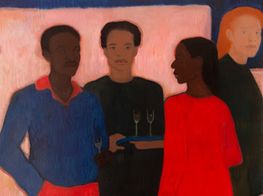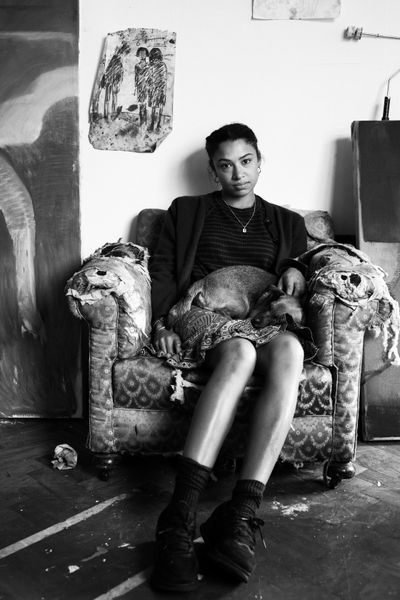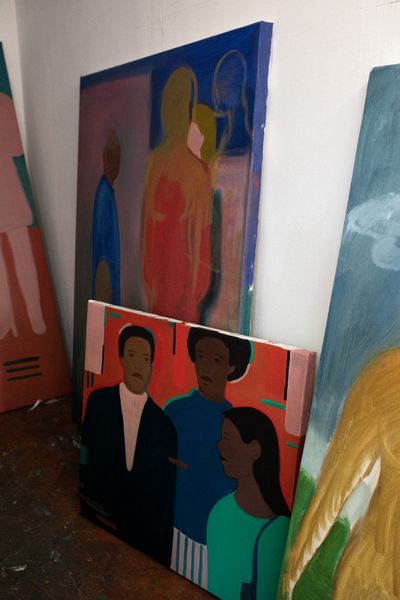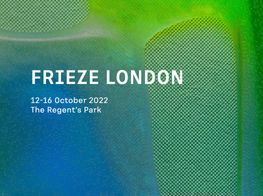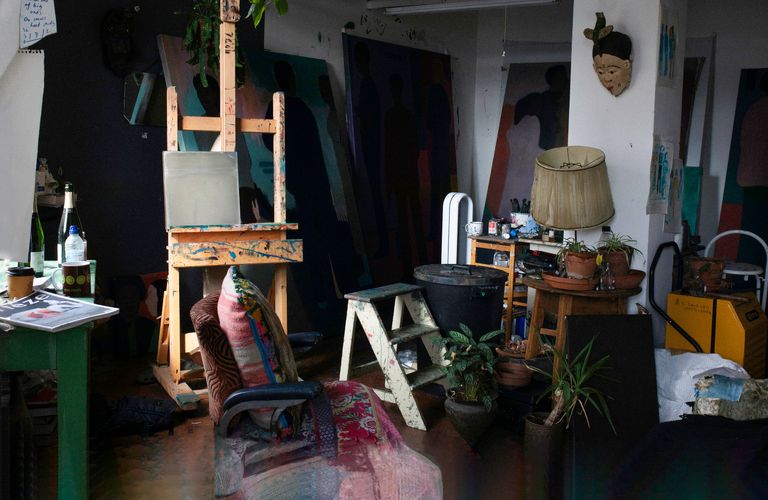
Sahara Longe's enigmatic array of characters dressed in vermillion, emerald, and lilac will be welcomed by lovers of figurative painting. Repurposing the colour palette and painterly techniques of Old Masters such as Rubens and John Singer Sargent, Longe's latest paintings explore the psychology of social interactions in party settings.
Ahead of her solo booth with Timothy Taylor for Frieze London, the young British artist discusses how the bustling scenes of German Expressionist paintings, and her classical art education at Charles H. Cecil Studios, play into her latest works.
You had quite an unusual art education compared to other contemporary painters today. How did your time at Charles H. Cecil Studios influence the way you approach figuration?
Yes, it was quite different. I thought I wanted to go into classical portraiture and commission-based work, so I trained for four years in painting and drawing. In the first year, it was all drawing—you weren't able to pick up a paintbrush.
The school used a sight-size technique, where you would line up the canvas alongside the sitter. You would walk back and forth, measuring the anatomy from far back before approaching the canvas to make a mark. You could spend up to ten weeks working on one figure, so it definitely taught me to be patient.
Learning how to mix colour was one of my biggest takeaways. We learned to mix pigment with tree sap that had been cut down with turpentine. It's this technique that gives Old Master paintings their shine. It allows you to work the painting for days afterwards, a process which is difficult to recreate with modern paint.
Your work includes references to Old Master paintings, including Rubens and John Singer Sargent. Could you tell me about your decision to draw these elements into your work?
Masters used to copy the masters before them—Rubens was influenced by Titian, while you can see characteristics of both of their works in the paintings of Van Dyck. I love looking at paintings and seeing these references and I like the idea of continuing that if possible.
The way John Singer Sargent paints hands is an element I've brought into my work. His hands are almost blocks—unrefined and very simplified. As for Rubens, if you look closely at his paintings he would softly outline his figures in red so as to separate them from the background.
My paintings at Frieze reference this idea, using bold red lines or accents in parts to define each form.
You were trained in oil painting and have followed a trajectory of creating oil-based works. What is it about the medium that you enjoy?
Oil paint is great as it's very experimental and makes everything feel alive. It also doesn't dry immediately. You can work it for days—playing with composition, angles, and colour—until you find what you feel happy with. I also soften my work a lot—you'll find there are few sharp edges in my work, and this is something that works well in oils.
I also paint onto either really thick grain linen or jute, a material that Old Masters, and more modern painters such as Gauguin were using. It's very thick so you can really press and work the oil paint into it. It's like a drum—I actually tried to stab one with a knife once and it was near impossible!
You have a very restrained and instantly recognisable colour palette, including vermillion red, lilac, and emerald green. Could you tell me a little about how you came upon these colours?
I used a very limited palette when I was training—ivory black, vermillion red, yellow ochre, raw sienna, lead white, and a bit of ultramarine blue. I still use this palette but have extended it slightly.
All my flesh tones are built from the same colours used by John Singer Sargent and Rubens, however, the emerald greens of Gauguin have begun to creep into my work.
I spend a lot of time researching the palettes of artists I love. Recently, I went to the Francis Bacon retrospective at the Royal Academy of Art and loved the purple used in his bullfighting series. I think I've come close, mixing magenta, white, and vermillion red—I would love to try and incorporate it into my paintings next year.
I understand that your upcoming presentation with Timothy Taylor for Frieze London explores the hidden psychology of social interactions. What inspired this angle for the paintings in this show?
Party scenes were a theme I started researching last year, as I thought it was an interesting way of showing how humans interact with one another. At the time I was fascinated by German Expressionist paintings, depicting bustling street scenes and warped interiors. The expressions people wore—exchanging stories, intimately dancing, or reacting to oddities—what I wanted this series of work to encapsulate.
All the scenes are from my imagination and I love brainstorming the compositions of each canvas—that's the most interesting part for me. Composition is of the utmost importance in classical painting—it's all about balance, and this is something I have taken forward in my practice.
What's next for you?
It's been quite busy with Frieze and my New York solo last month, so I'm hoping to have a bit of downtime in the next couple of months. I have a show with Timothy Taylor in May 2023, so in the meantime, I will enjoy wandering around London with my dog Gina, and get inspired for the projects ahead.—[O]
Main image: Sahara Longe Studio. Courtesy Ocula. Photo: William Waterworth.

